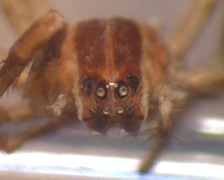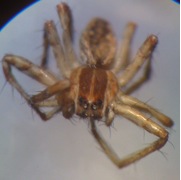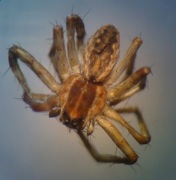Dark Fishing Spider
Contact
Katharine Ordway Natural History Study Area9550 Inver Grove Trail Inver Grove Heights, MN 55076 651-455-6204 (On Site)
651-696-6230 (On Campus)
andersonm@macalester.edu
Biotic Inventory
Documenting Diversity at the Katharine Ordway Natural History Study Area
Dolomedes tenebrosus, the Dark Fishing Spider



Taxonomy
Kingdom: Animalia
Phylum: Arthropoda
Class: Arachnida
Order: Araneae
Family: Pisauridae
Genus: Dolomedes
Species: tenebrosus1
Common names: Nursery Web Spiders, Fishing Spiders, the Dark Fishing Spider
Diagnostic characteristics
Whenever identifying a species of spider, the first place to go to for a distinguishing characteristic is the eyes. While markings may be useful for distinguishing species, markings can be very similar between species and even families, often overlapping. Especially for a species like this, which exhibits no bright colors or particularly unusual body plans, determining which family of spider this sample is dependant on certain morphological features, the eyes being the primary feature. While marking patterns may be very similar, eye patterns can be very unique to each family of spider.2
This organism, in particular, has a distinguishing set of eyes. Initially this sample appears to be a member of the Wolf Spider family Lycosidae due to its marking pattern. However, upon closer examination we see that this animal’s eye pattern gives it away. The Wolf Spider’s eyes are arranged in three rows, with two large eyes at the top, two large eyes in the middle, and four smaller eyes at the bottom. This individual’s eyes, on the other hand, are arranged in two rows, with larger eyes at the top. These larger eyes are key to the identification process, as only the Dolomedes genus of the Pisauridae family has eyes that follow this pattern.3
Once narrowed to the Dolomedes genus, other traits of this organism become more pertinant. The size of this animal is very small – around 7mm. Generally this is too small for a member of this family. The males are smaller, however this spider’s palps were too small for a fully developed male. Also, the marking patterns were relatively indistinct compared to the fully mature Dolomedes genus member. As a result, it is reasonable to believe that this organism is a juvinile.
This animal is specifically a member of the species Dolomedes tenebrosus due to its marking pattern and where it was found. Most members of the Dolomedes genus are water or swamp dwelling spiders. This spider, on the other hand, was found in underbrush a hundred yards from the Mississippi river. Dolomedes tenebrosus fits this pattern, as it is an opportunistic feeder often found in dry wooded areas near a water source.4
Ecology
These animals, when fully grown, live off the water. Instead of creating webs to catch their prey, members of the Dolomedes genus are hunters who stalk their meals. They habituate in areas near freshwater, and so those meals consist mainly of aquatic insects and small fish. They will even run on the water’s surface, using surface tension to maintain balance and buyancy. These animals are largely active during the night, hiding under trees or rocks during the day.
Dolomedes tenebrosus, though, is more adapted to land life than other members of the same genus. They often stray quite far from water, often living in wooded settings, and have even been reported in basements and bedrooms.5 Unlike their other Fishing Spider bretheren, they would be better classified as a tree-dwelling species.6 Their eating plans are far less specific than most other members of the Dolomedes genus; they have even been reported to consume slugs.7
Life History
Considering the life history of these organisms, it makes sense for this individual to be a juvinile. Dolomedes tenebrosus goes through a period of hibernation as juveniles, spending their time hidden under rocks and underbrush. They do not reach maturity until early May.6 Considering this spider was taken during early April, it makes sense that it would be a juvenile.
Upon reaching maturity when the weather warms up in the spring, D. tenebrosus most likely immediately attempts to find a mate and reproduce. This most likely takes place near a body of water, however mating behavior has only been observed once. That attempt ended with the female eating the male.8
Egg casings form in June, and are attached to the underside of the female until the underlings are ready to hatch. Egg casings are large compared to the organism, about 14 mm in diameter, and can contain up to 1400 baby spiders. Days before the eggs hatch, the female attaches the sac to some plant matter, and builds a nursery web around it. The hatchlings then live in the nursery web for some time afterwards, with the mother spider keeping guard of the web.4
Distribution
These spiders are unique to North America, but they have a very large range across the eastern half of the continent. D. tenebrosus has been found as far south as Florida and as far north as southern Canada, showing the wide variety of temperatures this species can survive under. Detailed studies have been performed in the New England states, particularly Connecticut, though this species has been documented as far west as Texas and the Dakotas. While there is nothing in the literature showing identificiations in the state of Minnesota, these spiders have been documented by amature entomologists in southeastern Minnesota.9 The discovery of a juvenile specimen at the Ordway Nature Preserve does establish the ability of these spiders to breed at these latitudes.
Voucher Information
This organism was found hidden in the underbrush of the Ordway Nature Preserve, roughly a football field away from the shore of the Mississippi river. Its larger environment was forested with a wide variety of oaks and birch trees.
References
1. Species Dolomedes tenebrosus. 2010. http://bugguide.net/node/view/2011
2. Myths about Identifying Spiders. 2003. http://www.washington.edu/burkemuseum/spidermyth/myths/easy.html
3. Spider Eye Arrangements. 2010. http://bugguide.net/node/view/84423
4. The Arthropod Museum: Dark Fishing Spider. 2003. http://www.uark.edu/ua/arthmuse/dolomede.html
5. Carico, J. E. 1973. The Nearctic species of the genus Dolomedes (Araneae: Pisauridae). Bulletin of the Museum of Comparative Zoology 144 (7): 435-488.
6. Fishing Spider. 2006. http://ento.psu.edu/extension/factsheets/fishing-spider
7. Kissane, K. C. 2001. Slug eating by the pisaurid spider Dolomedes tenebrous Hentz, 1843. British Arachnological Society Newsletter 91: 4-5.
8. Sierwald, P., and J. A. Coddington. 1988. Functional aspects of the male palpal organ in Dolomedes tenebrosus, with notes on the mating behavior (Araneae, Pisauridae). Journal of Arachnology 16: 262-265.
9. Large Spider in Rural Southeast Minnesota. 2005. http://bugguide.net/node/view/21350/bgimage
Compiled by Joe Lalli.
Biodiversity & Evolution (BIOL 270), Professor Sarah Boyer. Spring 2010.
Specimen collected at Macalester College’s Katharine Ordway Natural History Study Area on April 15, 2010.